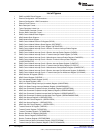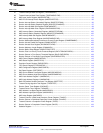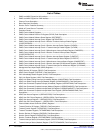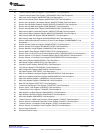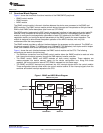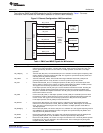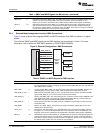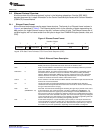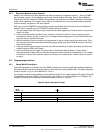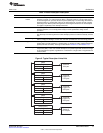
Architecture
www.ti.com
1.4 Industry Standard(s) Compliance Statement
The EMAC peripheral conforms to the IEEE 802.3 standard, describing the Carrier Sense Multiple Access
with Collision Detection (CSMA/CD) Access Method and Physical Layer specifications. The IEEE 802.3
standard has also been adopted by ISO/IEC and re-designated as ISO/IEC 8802-3:2000(E).
However, the EMAC deviates from the standard in the way it handles transmit underflow errors. The
EMAC MII interface does not use the Transmit Coding Error signal MTXER. Instead of driving the error pin
when an underflow condition occurs on a transmitted frame, the EMAC intentionally generates an incorrect
checksum by inverting the frame CRC, so that the transmitted frame is detected as an error by the
network.
2 Architecture
This section discusses the architecture and basic function of the EMAC peripheral.
2.1 Clock Control
All internal EMAC logic is clocked synchronously on one clock domain. See your device-specific data
manual for information.
The MDIO clock is based on a divide-down of the peripheral clock and is specified to run up to 2.5 MHz
(although typical operation would be 1.0 MHz). Because the peripheral clock frequency is variable, the
application software or driver must control the divide-down value.
The transmit and receive clock sources are provided by the external PHY to the MII_TXCLK and
MII_RXCLK pins or to the RMII reference clock pin. Data is transmitted and received with respect to the
reference clocks of the interface pins.
The MII interface frequencies for the transmit and receive clocks are fixed by the IEEE 802.3 specification
as:
• 2.5 MHz at 10 Mbps
• 25 MHz at 100 Mbps
The RMII interface frequency for the transmit and receive clocks are fixed at 50 MHz for both 10 Mbps
and 100 Mbps.
2.2 Memory Map
The EMAC peripheral includes internal memory that is used to hold buffer descriptions of the Ethernet
packets to be received and transmitted. This internal RAM is 2K × 32 bits in size. Data can be written to
and read from the EMAC internal memory by either the EMAC or the CPU. It is used to store buffer
descriptors that are 4-words (16-bytes) deep. This 8K local memory holds enough information to transfer
up to 512 Ethernet packets without CPU intervention. This EMAC RAM is also referred to as the CPPI
buffer descriptor memory because it complies with the Communications Port Programming Interface
(CPPI) v3.0 standard.
The packet buffer descriptors can also be placed in other on- and off-chip memories such as L2 and
EMIF. There are some tradeoffs in terms of cache performance and throughput when descriptors are
placed in the system memory, versus when they are placed in the EMAC’s internal memory. In general,
the EMAC throughput is better when the descriptors are placed in the local EMAC CPPI RAM.
2.3 Signal Descriptions
Support of interfaces (MII and/or RMII) varies between devices. See your device-specific data manual for
information.
2.3.1 Media Independent Interface (MII) Connections
Figure 2 shows a device with integrated EMAC and MDIO interfaced via a MII connection in a typical
system. The EMAC module does not include a transmit error (MTXER) pin. In the case of transmit error,
CRC inversion is used to negate the validity of the transmitted frame.
14
EMAC/MDIO Module SPRUFL5B–April 2011
Submit Documentation Feedback
© 2011, Texas Instruments Incorporated



